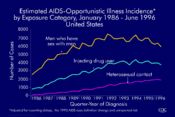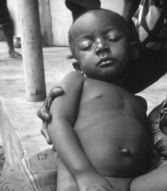|
<< History of AIDS last page || History
of AIDS next page >>
1986: Enter President Reagan
Another actor, who saw the news of Rock Hudson's 1985 death from AIDS, was by then
the 40th President of the United States, Ronald Reagan (1981-1989). On March 31,
1986, President Ronald Reagan made his first noteable mention of the word "AIDS"
publicly at the Third International AIDS Conference in Washington, D.C.,
|

Estimated AIDS-Opportunistic Illness Incidence
by Exposure Category: Line graph showing estimated
AIDS-opportunistic illness incidence
by exposure category, January 1986-June
1996, United States
Image Source: CDC/NCHSTIP/DHAP/Jean
G. Smith
|
recommending routine testing for AIDS. With his conservative agenda,
fiscal responsibility, not federal intervention would dictate his policies, but by
this time there were some 60,000 cases of full-blown AIDS and 30,000 deaths. In the
week prior to his State of the Union address, President Reagan said, "While
there are hopes for drugs and vaccines against AIDS, none is immediately at hand.
Consequently, efforts should focus on prevention, to inform and to lower risks of
further transmission of the AIDS virus. To this end, I am asking the surgeon general
to prepare a report to the American people on AIDS." Source: AEGIS.org Surgeon General C. Everett Koop (1982-1989) spent the next nine months
working on that report, releasing it on October 22, 1986. He followed it with a Public
Health Service brochure on CDC guidelines for AIDS -- "Understanding AIDS"
-- which he penned himself, and was sent out as the "largest public health mailing
ever done" to 107 million households in the United States in 1988. Source:
U.S. Department of Health and Human Services
Dr. Koop's pamphlet, "Understanding AIDS," warned in the introduction:
"AIDS is one of the most serious health problems that has ever faced the American
public." It discussed "What Behavior Puts You At Risk?" The pamphlet
classified "Risky Behavior" as: (1) Sharing drug needles and syringes,
(2) Anal sex, with or without a condom, (3) Vaginal or oral sex with someone who
shoots drugs or engages in anal sex, (4) Sex with someone you don't know well (a
pickup or prostitute) or with someone you know has several sex partners, and (5)
Unprotected sex (without a condom) with an infected person. Conversely, "Safe
Behavior" was stated as: (1) Not having sex, (2) Sex with one mutually faithful,
uninfected partner, and (3) Not shooting drugs. Source: AIDS Info BBS
1987: The Touch of a Princess
On March 20th of 1987, AZT (also known as Retrovir®, zidovudine, or ZDV) -- manufactured
by GlaxoSmithKline -- became the first anti-HIV drug (a Nucleoside Reverse Transcriptase
Inhibitor) to be approved by the Food and Drug Administration (FDA). AZT prevents
HIV by altering the genetic material of healthy T-cells. It must be used in combination
with at least two other anti-HIV drugs. AZT therapy may cause mutations in HIV's
structure, which prevent AZT from working against HIV. Source: AIDSmeds.com The very next month, in April
of 1987, Princess Diana affected the public perception of AIDS at the opening of
a specially built ward for AIDS sufferers at London's Middlesex Hospital, when she
was seen by the press not wearing gloves and shaking hands with people with AIDS,
demonstrating that "you can touch an AIDS victim and not catch it." Source:
AllFreeEssays.com In retrospect, on November 2, 2002, former South African President Nelson
Mandela, when announcing the joining of the Nelson Mandela Children's Fund with the
Diana, Princess of Wales Memorial Fund to assist South Africans with HIV/AIDS, their
families, and their orphans, he said, "When she stroked the limbs of someone
with leprosy, or sat on the bed of a man with HIV/AIDS and held his hand, she transformed
public attitudes and improved the life chances of such people." He continued,
"People felt if a British princess can go to a ward with HIV patients, then
there's nothing to be superstitious about." Source: The My Hero Project AIDS awareness had
a new ambassador in Diana Princess of Wales, whose compassion and actions promoted
a better understanding of people with AIDS. The Red Ribbon Foundation -- Educate
to Prevent - Research to Cure -- established in 1993, likewise promotes AIDS awareness,
raising money for AIDS research, and especially emphasizing their belief: "It
is with our youth that the seeds of ultimate triumph over the spread of AIDS will
be harvested." Speaking from the vantage point of 2004, they say that 40 million
people are living with HIV/AIDS (37 million adults and 2.5 million children under
age 15). 5 million people acquired HIV in 2003 (4.2 million adults and 700,000 children
under age 15). "3 million people from all walks of life, both sexes, young and
old, straight and gay, have died of AIDS, including over 500,000 children under the
age of 15." Source: The Red Ribbon Foundation
1990: Death of Ryan White
Ryan White, a nineteen year old, white, heterosexual, middle class teenager from
Kokomo, Indiana died on April 8, 1990 of AIDS, which he contracted from blood products,
as part of his treatment for hemophilia. He came to public attention, when he was
expelled from school for being a health risk. Afterwards, his parents, Wayne and
Jeanne White, along with Ryan and his sister Andrea moved to Cicero, Indiana, where
he was received at Hamilton Heights High School as a celebrity by those, who were
more fully educated into the nature of HIV. Source: Wikipedia In 1989, ABC aired "The
Ryan White Story," where Lukas Haas dramatized the role of Ryan. Judith Light
played the part of Jeanne White (Ryan's mother). Ryan even had the opportunity to
portray his real life friend, Chad. He appeared repeatedly on nationwide television
programs as one of America's most visible spokespersons for the AIDS
crisis. He was befriended by celebrities such as Elton John, Michael
Jackson, Greg Louganis, Alyssa Milano, Charlie Sheen, and Elizabeth Taylor, speaking
out for the compassionate treatment of AIDS sufferers. Source: Internet Movie Database At the age of sixteen,
Ryan testified before the President's Commission on AIDS, under the Reagan administration.
Source: Wikipedia If he had survived, he planned
to attend Indiana University. Source: Indiana University Just a few months after
Ryan's death, the U.S. Congress passed on August 18, 1990, Public Law 101-381, the
Ryan White Comprehensive AIDS Resources Emergency (CARE) Act to assist local health
care delivery systems in providing care for people with AIDS, who do not have adequate
health insurance or other resources. As of 1998, as a result of the Ryan White CARE
Act, more than $6.4 billion in federal funds have been appropriated, and about 500,000
individuals with AIDS and HIV are served in a given year. Source: FindLaw Ryan emphasized the success of AIDS education in his testimony before the
President's Commission on AIDS. HIV testing is the first step in your personal education
in determining if you are infected with the Human Immunodeficiency Virus (HIV). HIV
tests look for antibodies to HIV. Those antibodies are proteins produced by your
immune system to fight germs. Blood tests are the most common HIV test, but newer
tests can detect antibodies in mouth fluid, from scrapings inside your cheek, or
from your urine. Rapid HIV tests are now capable of test results within 10 to 30
minutes after a sample is taken. Between three weeks and two months after becoming
infected with HIV, your immune system produces antibodies to HIV, so you should wait
two months before being tested, after you think you were exposed to HIV. Tests are
confidential, though the CDC has proposed keeping track of names -- without any action
taken, thus far. Test results are more than 99.5% accurate. Source: New
Mexico AIDS InfoNet Good nutrition, in particular extra
muscle weight, helps the body fight HIV. Though most people want to lose weight,
for people with HIV, it can be dangerous. If you lose too much lean weight, i.e.,
more than 5% of your body weight, your body chemistry changes. This is called wasting
syndrome or cachexia, which can kill you. Talk with your doctor. Suggested reading
by the New Mexico AIDS InfoNet for nutrition, HIV, and AIDS: (1) A Clinician's Guide To Nutrition In HIV and AIDS by Cade Fields-Gardner and others, published by the American Dietetic Association,
$26 plus $5 shipping and handling: The American Dietetic Association, P.O. Box 97215,
Chicago IL 60678-7215; or 800-877-1600, ext. 5000, (2) Eat Up! Nutrition Advice and Food Ideas for People Living with HIV and
AIDS by Charlie Smigelski, RD, $10.00, and (3) Nutrition and HIV: A New Model for Treatment
by Mary Romeyn, MD, $18.95, published by Jossey-Bass, Inc, telephone 415 433 1740.
Source: New Mexico AIDS InfoNet
<< History of AIDS last page || History
of AIDS next page >>
The History of AIDS © 2005
Legal Disclaimer: "The History of AIDS" is not affiliated
in any way with the organizations, or third party links found at this website, with
the exception of links to Amazon.com. The information at this website should not
be taken as medical advice, treatment, or diagnosis, express or implied. Even though
a reasonable effort has been made to present correct information, no warranty is
made that the data at this website is true or accurate. Consult your health care
professional before beginning ANY treatment or regimen.
Member of Fohn.net
|


